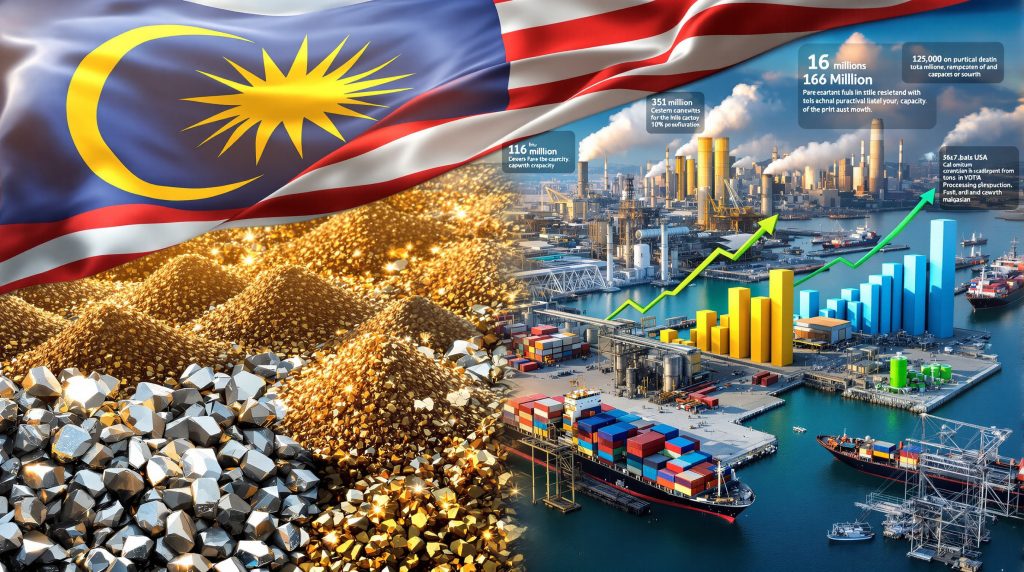Understanding Malaysia's Strategic Resource Protection Policy
Malaysia's decisive move to restrict unprocessed rare earth exports reflects a fundamental shift toward resource sovereignty, prioritizing domestic value creation over traditional commodity trading approaches. This comprehensive policy framework, designed to protect the nation's estimated 16.1 million metric tons of rare earth deposits, demonstrates how resource-rich developing economies are restructuring their mineral beneficiation opportunities strategies.
The policy represents Malaysia's rejection of what Trade Minister Tengku Zafrul Aziz characterised as the historical pattern where nations function merely as suppliers that extract and export cheap raw materials while importing expensive finished products. Instead, Malaysia's ban on raw rare earths exports seeks to capture greater economic value through domestic processing before any materials reach international markets.
Unlike blanket trade restrictions, Malaysia's approach distinguishes between preventing commerce entirely versus preventing the export of unprocessed materials. This nuanced strategy aims to encourage foreign investment and technology transfer for mining and processing operations while ensuring that value addition occurs within Malaysian borders before export.
What Are the Key Components of Malaysia's Export Restrictions?
Scope of Material Classifications
Malaysia's export restrictions operate through a sophisticated classification system that distinguishes processed materials from raw extracts:
- Prohibited Exports: Unprocessed rare earth ores, concentrates, and primary extraction outputs
- Permitted Exports: Refined rare earth elements, processed compounds, and finished products containing rare earth materials
- Universal Application: Restrictions apply consistently across all trading partners, including major markets in Asia, Europe, and North America
- Implementation Timeline: Full enforcement commenced January 1, 2024, following preliminary measures introduced in late 2023
Regulatory Framework and Oversight Mechanisms
The Natural Resources, Environment and Climate Change Ministry maintains primary authority over export licensing and compliance monitoring. State-level governments must align their policies with federal trade jurisdiction requirements, ensuring consistent implementation across Malaysia's diverse regional economies.
Furthermore, export licensing systems now track material processing status to distinguish between raw and refined products. Companies seeking export permits must demonstrate that their materials have undergone sufficient processing to qualify for international sale, with periodic policy assessments evaluating effectiveness and market conditions.
Why Did Malaysia Implement These Export Controls Despite International Pressure?
Economic Transformation Beyond Resource Extraction
Malaysia's ban on raw rare earths exports directly addresses the economic phenomenon known as the "resource curse," where nations rich in natural resources experience stunted economic development due to over-reliance on raw commodity exports. The policy framework specifically targets escape from patterns where countries export cheap materials while importing expensive manufactured goods.
Minister Tengku Zafrul Aziz emphasised Malaysia's determination to avoid remaining trapped in historical patterns of resource dependency. The nation's strategy centres on encouraging establishment of refining and processing infrastructure within Malaysian borders, creating higher-skilled employment opportunities in processing rather than extraction alone.
Value Capture Through Domestic Processing
The policy aims to generate substantially greater government revenues through value-added processing retention. Rather than selling raw materials at commodity prices, Malaysia seeks to capture profit margins typically earned by processing facilities in other countries.
Key Economic Objectives Include:
- Domestic processing facility development encouraging foreign investment coupled with technology transfer
- Employment creation in higher-value manufacturing and processing sectors
- Revenue optimisation through capturing downstream profit margins
- Technology transfer requirements ensuring knowledge sharing accompanies market access
How Do Recent US-Malaysia Trade Agreements Affect the Export Ban?
Critical Minerals Partnership Structure
The bilateral agreement signed during President Trump's October 26, 2025 visit to Kuala Lumpur includes specific provisions regarding critical minerals cooperation while maintaining Malaysia's fundamental policy position. The United States signed parallel agreements with both Malaysia and Thailand during the same regional visit, seeking cooperation to diversify critical minerals energy transition supply chains amid competing efforts from China.
According to Malaysia's official trade clarification, Malaysia agreed to refrain from banning or imposing quotas on exports of critical minerals or rare earth elements to the United States. However, this commitment applies specifically to processed materials rather than raw extracts, maintaining consistency with Malaysia's core export restriction policy.
Policy Consistency Analysis
Despite international agreements, Malaysia maintains its fundamental position against raw material exports. In addition, the US-Malaysia agreement creates framework for:
- Technology Sharing: Collaborative development of processing facility capabilities
- Supply Chain Diversification: Reducing global dependence on Chinese processing capacity
- Investment Facilitation: Streamlined approval processes for US companies establishing processing operations
- Strategic Cooperation: Enhanced coordination on critical minerals supply security
Minister Tengku Zafrul Aziz clarified that Malaysia's ban on raw rare earths exports does not prevent trade permanently, but specifically targets unprocessed materials to ensure value addition occurs domestically before export.
What Are Malaysia's Rare Earth Processing Capabilities and Limitations?
Current Infrastructure Assessment
| Development Area | Current Status | Investment Requirements |
|---|---|---|
| Mining Technology | Limited domestic expertise | Foreign partnership arrangements |
| Processing Facilities | Minimal refining capacity | Multi-billion dollar capital investment |
| Technical Workforce | Specialised personnel shortage | Comprehensive education and training programs |
| Environmental Standards | Developing regulatory framework | International best practices implementation |
Partnership Development Strategies
Malaysia currently lacks the technology to mine and process its substantial rare earth deposits, necessitating foreign investment and partnerships. Khazanah Nasional, Malaysia's sovereign wealth fund, is exploring refinery partnerships with Chinese firms to establish domestic processing capabilities.
Foreign Investment Requirements Include:
- Technology transfer obligations as conditions of market access
- Joint venture partnerships with Malaysian entities
- Advanced processing techniques meeting environmental permit requirements
- Local employment mandates ensuring Malaysian workforce development
- Environmental compliance meeting enhanced sustainability standards
Consequently, the government offers attractive investment packages including reduced corporate tax rates, streamlined industrial development approval processes, and infrastructure support for qualifying processing facilities.
How Does This Policy Impact Global Rare Earth Supply Chain Security?
Market Concentration and Vulnerability Analysis
Malaysia's export restrictions contribute to broader global supply chain vulnerabilities, particularly given existing market concentration patterns. China currently controls over 60% of global rare earth processing capacity, creating significant bottlenecks for manufacturers requiring these materials for high-tech production.
Supply Chain Risk Factors:
- Processing bottlenecks with limited alternative refining facilities outside China
- Strategic dependencies as Western manufacturers become increasingly reliant on Chinese-processed materials
- Price volatility where supply restrictions can amplify market fluctuations
- Geographic concentration limiting supply diversification options
Geopolitical Implications for Supply Security
Western strategic responses include accelerated investment in alternative processing locations and enhanced partnerships with resource-rich democratic allies including Australia and Canada. Government strategic stockpiling initiatives aim to buffer against potential supply disruptions while increased funding supports rare earth recycling and alternative material research.
However, the combination of Chinese processing dominance and Malaysia's ban on raw rare earths exports creates system-wide supply risks that could significantly impact industries dependent on rare earth materials, including electric vehicle manufacturing, semiconductor production, and defence applications.
What Investment Opportunities Emerge from Malaysia's Processing Focus?
Foreign Direct Investment Incentive Structure
Malaysia offers comprehensive investment packages designed to attract rare earth processing facilities, recognising the multi-billion dollar capital requirements for establishing modern refining operations. Furthermore, the government provides regulatory certainty through long-term policy commitments to processing sector development.
Investment Incentive Components:
- Tax Benefits: Reduced corporate tax rates for qualifying processing facilities
- Land Access: Streamlined approval processes for industrial development projects
- Infrastructure Support: Government investment in supporting utilities and transportation networks
- Regulatory Certainty: Long-term policy commitments ensuring investment security
Technology Partnership Models
Foreign companies typically require local partnership arrangements to access Malaysian rare earth resources. Technology sharing serves as a fundamental condition of market access, with environmental standards requiring advanced processing techniques for permit approval.
Partnership Requirements Include:
- Joint venture arrangements with Malaysian entities
- Knowledge transfer obligations covering processing technologies
- Environmental compliance meeting international sustainability standards
- Local employment requirements ensuring Malaysian workforce participation
- Community engagement protocols for project development
For instance, the Khazanah Nasional partnership exploration with Chinese firms demonstrates Malaysia's pragmatic approach to accessing necessary processing technologies while maintaining domestic ownership stakes in development projects. This connects to broader mining industry evolution trends across Southeast Asia.
How Do Environmental Considerations Shape Malaysia's Rare Earth Policy?
Sustainability Framework Development
Malaysia's policy framework incorporates lessons learned from historical rare earth extraction challenges, emphasising environmental protection as a core component of resource development. The approach requires comprehensive environmental impact assessments for all new projects, with community consultation processes ensuring local stakeholder engagement in project planning.
Environmental Requirements Include:
- Advanced tailings and byproduct handling protocols
- Mining company funding obligations for site rehabilitation
- Comprehensive waste management systems meeting international standards
- Community consultation requirements for all development phases
International Best Practices Integration
Malaysia adopts proven environmental management techniques from leading mining jurisdictions, incorporating Australian environmental standards, Canadian northern climate processing technologies, and European sustainability requirements for export market access.
Technology Innovation Focus Areas:
- Cleaner extraction methods reducing environmental impact
- Advanced processing techniques minimising waste generation
- Water quality protection systems for mining operations
- Air emissions control meeting international standards
Investment in environmental compliance technology represents both a regulatory requirement and competitive advantage, enabling Malaysian processed materials to meet stringent international market standards while protecting domestic environmental resources. This aligns with global mine reclamation innovation trends.
What Are the Long-term Strategic Implications for Global Markets?
Resource Nationalism Trend Analysis
Malaysia's policy reflects broader global trends toward resource sovereignty, with multiple nations implementing similar strategies to capture greater value from natural resource endowments. Indonesia's nickel ore export restrictions and Chile's lithium extraction controls demonstrate comparable approaches to domestic value addition requirements.
Global Resource Policy Trends:
- African nations emphasising local value addition in mineral-rich regions
- Supply chain reshaping as manufacturers adapt to new geographic processing centres
- Investment flow redirection from extraction toward processing projects
- Technology transfer acceleration driven by resource access requirements
Market Structure Evolution Predictions
Malaysia's positioning suggests potential emergence as a Southeast Asian rare earth processing hub, fundamentally altering regional supply chain dynamics. Market structure changes will likely include greater premiums for processed versus raw materials, reflecting the added value of domestic processing capabilities.
Predicted Market Developments:
- Processing Hub Formation: Malaysia emerging as regional centre for rare earth refining
- Price Structure Evolution: Increasing premium differential between raw and processed materials
- Capital Allocation Shifts: Investment moving from extraction to processing infrastructure
- Knowledge Transfer Expansion: Enhanced technology sharing to secure resource access
The long-term implications extend beyond Malaysia's borders, potentially encouraging other resource-rich nations to implement similar value-addition requirements. This trend could fundamentally reshape global commodity trading patterns, with processed materials commanding premium pricing while raw material access becomes increasingly restricted. Such developments may influence broader trade and critical minerals policy discussions globally.
Additionally, these policy shifts will likely force manufacturers to reassess their supply chain strategies. The ongoing export restrictions create new competitive dynamics that favour countries with established processing infrastructure while challenging those dependent on raw material imports.
Investment Disclaimer: The analysis presented represents current market conditions and policy frameworks as of late 2025. Resource nationalism policies and international trade agreements remain subject to change based on geopolitical developments and economic conditions. Investors should conduct independent due diligence before making investment decisions based on rare earth market dynamics or Malaysian policy frameworks.
Looking to Capitalise on Rare Earth Market Shifts?
Discovery Alert's proprietary Discovery IQ model delivers real-time alerts on significant rare earth and critical minerals discoveries across the ASX, instantly empowering subscribers to identify actionable opportunities ahead of the broader market. Visit Discovery Alert's dedicated discoveries page to understand why historic mineral discoveries have generated substantial returns, then begin your 30-day free trial today to position yourself ahead of evolving commodity markets.




